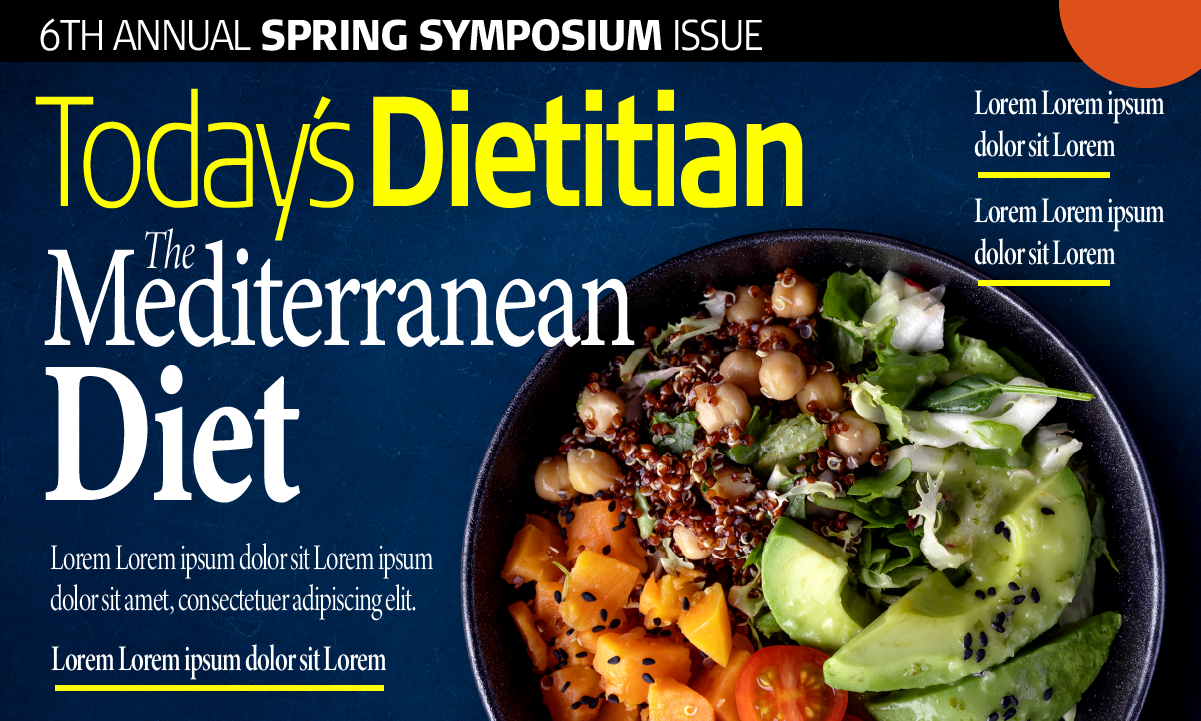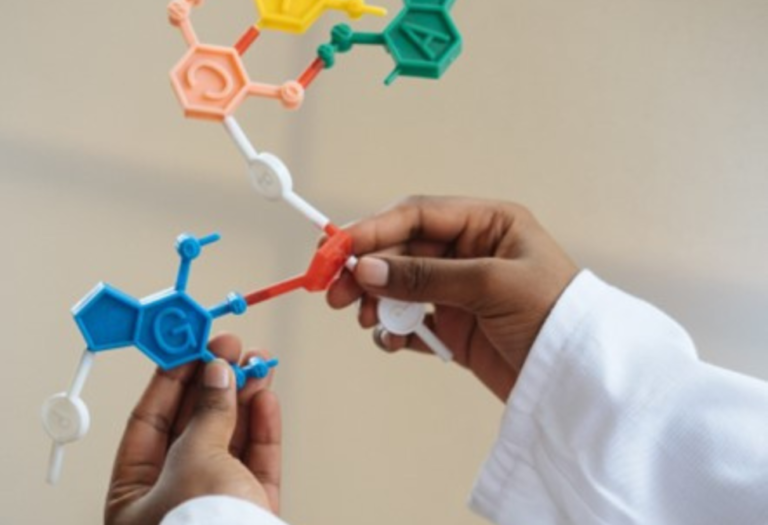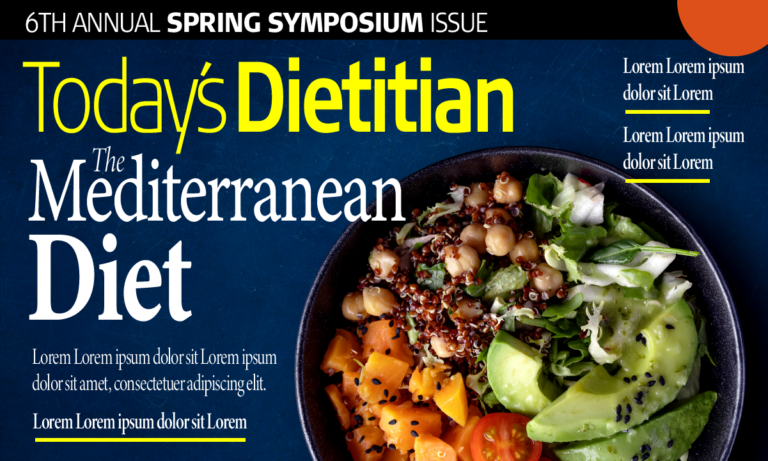Ready for personalized nutrition advice?
Personalized counseling has long been the cornerstone. Dietitians routinely encourage clients to make reasonable dietary and lifestyle changes, and base their recommendations on the client's current diet, health status, health goals, income, cultural and dietary preferences, health and wellness awareness, willingness to make changes, and more. Genetic testing can provide additional information on which to base personalized recommendations.
Research studies examining weight loss, insulin sensitivity, CVD risk factors and more demonstrate the results of various dietary interventions on average, but there is wide variation in response. Some participants respond to the diet and others don't. Why? Genetic differences may explain part of it. With the sequencing of the human genome in 2003, the idea of providing practical lifestyle and nutrition guidance based on one's genetic makeup seemed to be a possibility.
What is nutritional genomics?
Nutritional genomics involves the ways in which nutrients and genes interact and are expressed to reveal phenotypic outcomes, including disease risk. In practical terms, for consumers, it attempts to answer the question of how diet and genes affect each other.
The human genome consists of about 3 billion base pairs, and only about 0.1% of these bases differ between individuals. The most common type of genetic variation is called a single nucleotide polymorphism (SNP), which is a variation involving a single base pair of a nucleotide, the building blocks of DNA. For example, at a specific point in the DNA sequence, an individual may have inherited a cytosine nucleotide from both parents, conferring a typical risk for a health trait. Or, that individual may have inherited two copies of a thymine nucleotide at that same position, which may confer an increased risk. Each person has approximately 4 to 5 million SNPs. Most occur outside of genes, but when SNPs occur within a gene or in a regulatory area near a gene, they can affect gene function and play a direct role in disease.
Gene testing
When dietitians or other health professionals, information about a client's family history of obesity or disease, they are glimpsing genetic data by inference. However, it is impossible to know the role of shared genetics versus the role of shared environment. Actual genetic testing could uncover genetic variants that influence how dietary components are absorbed, metabolized, and utilized, and whether individuals are at risk for obesity or other health conditions.
Growing interest in personalized medical care and curiosity about ancestry has led to a boom in direct-to-consumer genetic testing, as well as nutrition-related genetic testing interpreted by dietitians. In recent years, improvements in testing technologies have significantly reduced the expense and turnaround time for genetic testing. "While it used to take months to genotype dozens of SNPs, now millions of SNPs can be genotyped more quickly," says Scott Thompson, chief operating officer of Genetic Direction, a genetic testing provider in the USA. He says that the cost of genotyping has been reduced across the industry and, in the last five years, the cost at Genetic Direction has been reduced by more than 50%. As a result, testing is available to more people. According to the Centers for Disease Control and Prevention, millions of people have participated in DTC genetic testing for ancestry data, which is often combined with health data.
Genetic testing companies offer a range of programs for weight loss, heart health, athletic performance, macronutrient and micronutrient metabolism, and more. Consumers access genetic testing directly or through dietitians and other medical professionals.
How the tests are performed
Typically, the consumer places a sample of saliva or cells from the inside of the cheek in a package provided by the testing company and this is mailed to the laboratory. At the laboratory, DNA is extracted from the sample, isolated and analyzed to determine the consumer's genotype for a specific set of SNPs. Finally, the company interprets the SNP genotypes and generates a report, which goes directly to the consumer for self-interpretation, or the report can be sent to a dietitian or weight loss counselor for discussion with the consumer.
The content of a report and actionable advice will vary by genetic testing company. One company may test for 45 genetic markers, while another may test for 50 or only 30 markers. In addition, each company may look for different markers for the same health trait. For example, one company may test seven genes to assess how the body metabolizes fat, and another will test more or fewer. This can lead to differences in the interpretation of a health trait and subsequent dietary recommendations. Even if two companies look at the same genes, their proprietary algorithms may weight the genes differently and generate different recommendations.
Scientific advisors review the literature to determine which genetic markers to consider for specific traits and create algorithms when more than one marker is used to assess the same trait, for example, the ability to lose and maintain weight. A variety of studies can provide these data. For example, large studies including the Preventing Overweight Using Novel Dietary Strategies (POUNDS LOST) trial have identified genes that play a role in weight loss, says Mark Sarzynski, PhD, FACSM, FAHA, assistant professor at the Arnold School of Public Health at the University of South Carolina and the director of genomics research at Genetic Direction. In the POUNDS LOST study, 811 obese or overweight subjects were assigned to one of four heart-healthy eating plans with varying levels of macronutrients for two years. Although weight losses were similar among the various plans, further analysis suggested that people with a particular genotype lost more pounds on a high-carbohydrate diet, while people with a different genotype fared better on a high-protein diet. Some observational studies have also found significant interactions between genes and diet.5 Although the research is clear that a variety of eating plans facilitates weight loss, the goal of genetic testing companies is to identify an optimal approach for each individual and provide DNA-based diet and lifestyle. advice in general.
However, not all experts agree that the science provided by DNA testing companies is ready for widespread use. According to George P. Patrinos, PhD, a professor in the department of pharmacy at the University of Patras in Patras, Greece, and a full member and national representative of the European Medicines Agency's CHMP pharmacogenomics working group in Amsterdam, the Netherlands, more evidence is lacking to support that diet can be individualized based on a panel of a few genomic variants. However Patrinos et al. conducted a meta-analysis of approximately 1200 studies involving 38 genetic variants offered by commercial nutrigenetic testing companies, and concluded that these 38 genetic variants were associated with the occurrence of nutrient-related conditions such as obesity and diabetes.
Genetic testing companies should ensure valuable consumer information reporting.
Timothy Caulfield, LLM, FRSC, FCAHS, chair of Canada Research in Health Law and Policy and professor and faculty of law and the School of Public Health at the University of Alberta, believes the research around nutrition-related genetic testing is making increasing progress. "To me, the data is starting to become definitive enough to justify the kind of marketing and pop culture noise we're seeing." he says.
How dietitians use genetic testing
Experts agree that physicians should order tests to diagnose or treat a disease. Disease risk genes are those that directly predict the likelihood of developing a disease. They are called high-penetrance genes if there is a very high probability of developing the condition simply by having the genetic variant, explains Ahmed El-Sohemy, PhD, professor and Canada Research Chair in Nutrigenomics at the University of Toronto and founder and chief scientific officer of Nutrigenomix Inc, a multinational genetic testing company with more than 8,000 professionals in 35 countries. An example of a high penetrance gene is BRCA1, which is a rare genetic variant with a very high probability of developing breast cancer. Fortunately, these types of genetic variants are not common, but "require the guidance of a physician or genetic counselor," he says.
Nutrigenomix, Genetic Direction and many other companies generally analyze and provide reports on low-penetrance genes, which are genes that suggest an increased risk of disease or modifier genes. Modifier genes affect metabolism or response to nutrients and various dietary factors such as caffeine, sodium and gluten, El-Sohemy explains. For example, having a risk variant of the CYP1A2 gene does not influence the known risk of any condition by itself. "But having the risk variant means you're inefficient at metabolizing or detoxifying caffeine. So, being a slow CYP1A2 metabolizer will increase your risk of heart disease if you drink more than two cups of coffee," he adds. However, research linking coffee consumption to CVD risk based on genetic variants is mixed.7 Another modifier gene is the ACE gene, which directs the body to produce angiotensin-converting enzyme. Individuals with a risk variant for the ACE gene are at risk for high blood pressure in the presence of a high-sodium diet.
Dietitians are implementing genetic testing in a variety of settings.
Cindy H. Carroll, MS, RD, LDN, RN, IFNCP, of Bedford, Massachusetts, has used genetic testing in her private practice for approximately five years within a variety of clinical areas, including weight management. One interesting application is a SNP that links weight gain to saturated fat intake. "Not everyone is sensitive to saturated fat, in terms of their weight, but some people with this SNP may be," he explains. High saturated fat intake can stall weight loss, even when calorie intake is reduced, he adds.
According to Kristin Kirkpatrick, MS, RDN, a wellness nutrition services consultant at the Cleveland Clinic Wellness Institute, many patients are more fully accepting of dietary changes based on genetic test results. For example, among other changes, one client included more omega-3 fatty acids based on a gene related to triglycerides and more whole grains based on a gene associated with an increased risk of type 2 diabetes.
Kassandra Gyimesi, RDN, owner of Personalized Nutrition Concierges, LLC, a Denver-based virtual practice, provides nutrition-related genetic testing through Nutrigenomix. She notes that clients want dietary guidance unique to them. After seeing the cardiometabolic results of her DNA report, a recent client with hypertension and no genetic family history to draw on was motivated to reduce her caffeine and sodium intake. Both the client and her physician were delighted with the results, Gyimesi says.
Nanci Guest, PhD, RD, CSCS, who is on the scientific advisory board of Nutrigenomix, uses genetic testing in her private practice in Toronto, Ontario. Guest and colleagues conducted a randomized controlled trial of more than 100 athletes. They found that both 2 mg/kg and 4 mg/kg caffeine improved 10-km cycling time, but only in those with a specific CYP1A2 genotype. Increased caffeine had no effect in athletes with a different genotype and even impaired performance in those with a third genotype. "CYP1A2 genotype should be considered when deciding whether an athlete should use caffeine to improve endurance performance," he explains.
Nutrisystem integrated an optional genetic testing component to its weight loss program last year. According to Courtney McCormick, MPH, RDN, LDN, manager of clinical research and nutrition at Nutrisystem, survey data showed that "3 out of 4 people who intended to diet believed that the knowledge provided by genetic testing would increase their motivation to both diet and exercise." Nutrisystem, in partnership with Genetic Direction, developed a genetics-based report that includes data associated with weight management, eating behaviors, exercise response, caffeine metabolism, and metabolism of specific micronutrients.
Best practices
When it comes to interpreting genetic test results to counsel clients, it's important that dietitians first be well-trained, says Martin Kohlmeier, MD, PhD, professor of nutrition and director of the Nutrigenetics Laboratory and Human Research Core at the University of North Carolina (UNC) Nutrition Research Institute. Just as there are nuances in the proper interpretation of laboratory results and recommendation of treatment, there are careful distinctions to be made with the review of genetic testing and the guidance derived from it. Therefore, proper use of genetic information cannot occur without additional effort and training, he adds. Both the UNC Nutrition Research Institute and the International Society for Nutrigenetics/Nutrigenomics offer training programs for health professionals. Dietitians should keep the following guidelines in mind:
- Research the genetic testing company. Before integrating nutrition-related genetic testing into their practices, dietitians should seek out genetic testing partners. Start by making sure the lab is reputable, Thompson says. And make sure that both the genes tested and the research used to perform the evaluations are publicly available in the report, he adds.
- Review a sample report for completeness and ease of use. Some companies combine their reports with recommendations for their own brand of supplements, which some dietitians will find helpful, but others will see as a conflict of interest.
- Interpret DNA testing with caution. Mascha Davis, MPH, RDN, works with Pathway OME in her Los Angeles-based private practice. She emphasizes the importance of understanding that these tests show predispositions, and clients should understand that. Carroll notes that DNA testing should be used in conjunction with traditional screening measures and clinical presentation. For example, the predisposition of a SNP gene to a nutrient deficiency should not lead to supplementation without checking for an actual deficiency. But certain SNPs may help explain why some people need supplements, he explains. Also, genetic testing should be combined with other proven strategies such as medications or calorie control, as indicated, Thompson adds. McCormick suggests using the DNA report as an opportunity to start the motivational interviewing process. Find out what areas the client wants to start with and plan small behavioral changes, she adds. Knowing information about their genes gets patients excited.
A customer may bring in an unfamiliar report from an outside testing company. Recognize that some DTC testing companies have little science behind their reports, and it may be better to guide the client to other bases for behavioral change. As an extreme example, one DNA report noted the possibility of a choline deficiency. The user was instructed to consume at least 550 mg of choline per day, which, according to the report, could be satisfied by consuming three cups of raw lentils or three items from a fast food restaurant per day, recommendations that dietitians would probably not make.
Additional criticisms
Last year, the DIETFITS (Diet Intervention Examining the Factors Interacting with Treatment Success) study suggested that genotyping to choose an ideal macronutrient intake for weight loss does not fully work. The study found no greater weight loss when dieters were randomly assigned to either their DNA-matched diet or a mismatched diet. According to El-Sohemy, "this study did not find a gene-diet interaction because the researchers simply chose the wrong SNPs, which had not been linked to weight loss in any previous studies." It's like looking at the lactase gene to predict response to gluten, he adds.
Caulfield says that "given that a large portion of the population does not come close to meeting basic nutrition recommendations, it seems absurd to focus on a high-tech niche technology backed by science." In addition, he worries that taking an individualized approach to nutrition will shift the policy focus away from the kind of population-level actions that can have a big impact.
Whether or not experts favor the widespread use of nutrigenomics testing for healthy people, researchers agree that the science will continue to provide new insights.
- Jill Weisenberger, MS, RDN, CDE, CHWC, FAND, is the author of four books, including Prediabetes: A Complete Guide. She is a freelance writer and nutrition and diabetes consultant to the food industry, and has a private practice in Newport News, Virginia.
Referencias
- Camp KM, Trujillo E. Academy of Nutrition and Dietetics charge: nutritional genomics. Diet J Acad Nutr. 2014;114(2):299-312.
- What are single nucleotide polymorphisms (SNPs)? National Institutes of Health, U.S. National Library of Medicine, Genetics Home Reference website. https://ghr.nlm.nih.gov/primer/genomicresearch/snp. Updated March 19, 2019.
- Ferguson LR, De Caterina R, Görman U, et al. International Society for Nutrigenetics/Nutrigenomics guidance and position on personalized nutrition: part 1: fields of precision nutrition. J Nutrigenet Nutrigenomics. 2016;9(1):12-27.
- Bowen S, Khoury MJ. Consumer genetic testing is booming, but what are the benefits and harms to individuals and populations? Centers for Disease Control and Prevention website. https://blogs.cdc.gov/genomics/2018/06/12/consumer-genetic-testing/. Published June 12, 2018. Accessed February 22, 2019.
- Qi L. Gene-diet interaction and weight loss. Curr Opin Lipidol. 2014;25(1):27-34.
- Pavlidis C, Lanara Z, Balasopoulou A, Nebel JC, Katsila T, Patrinos GP. Meta-analysis of genes in commercially available nutrigenomic tests denotes lack of association with dietary intake and nutrient-related pathologies. OMICS. 2015;19(9):512-520.
- Zhou A, Hyppönen E. Long-term coffee consumption, genetics of caffeine metabolism and risk of cardiovascular disease: a prospective analysis of up to 347,077 people and 8368 cases. I'm J Clin Nutr. 2019;109(3):509-516.

















